|
The Monument to Balzac originally was commissioned to the sculptor
Henri Chapu. When Chapu died in 1891, his work still unfinished, Emile
Zola, the new president of Societé des Gens de Lettres, set all
wheels in motion so that Rodin was invited as a candidate.
Rodin promised to deliver a three meters tall bronze sculpture within 18
months, till January 1893,
to be placed at the Palais-Royal in Paris, and was accepted by the Societé.
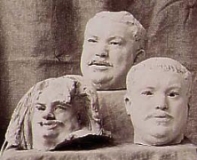 To
capture the spirit of the writer who had died in 1850, Rodin followed his
traces and made several trips to the Tourraine, Balzac's home region,
making clay portrait sketches of men with a similar physiognomy. To
capture the spirit of the writer who had died in 1850, Rodin followed his
traces and made several trips to the Tourraine, Balzac's home region,
making clay portrait sketches of men with a similar physiognomy.
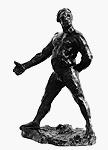 The
numerous preparatory studies show Balzac nude and paunchy or athletic,
later in his preferred work clothes, the Dominican cowl. In 1892, Rodin
finished an outline for the 'Monument to Balzac', standing and draped.
Years went by – Rodin had not finished his model yet. In 1894, the Societé
threatened to dissolve the contract and pass the commission to another
sculptor, Alexandre Falguière. Rodin put the 10,000 francs he had
received in advance in escrow, and promised to speed up his work on the
monument. The
numerous preparatory studies show Balzac nude and paunchy or athletic,
later in his preferred work clothes, the Dominican cowl. In 1892, Rodin
finished an outline for the 'Monument to Balzac', standing and draped.
Years went by – Rodin had not finished his model yet. In 1894, the Societé
threatened to dissolve the contract and pass the commission to another
sculptor, Alexandre Falguière. Rodin put the 10,000 francs he had
received in advance in escrow, and promised to speed up his work on the
monument.
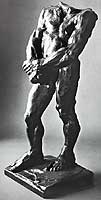 The
final version dates only 1897 - in the meantime the work on the 'Balzac'
had slowed down due to Rodin's serious illness and his many other
commissions. Still in the spring of that year, Rodin had worked on a
Balzac with arms crossed, striding forward. But later, he abandoned this
pose and started working on version 'F': an athletic figure with bulging
muscles, holding his stiff penis and leaning slightly backwards - an attitude his younger colleague
Medardo Rosso claimed to be 'stolen' from his 'Bookmaker'. Rodin ordered
six plaster casts to be made, and had them covered with cloth, soaked in
wet plaster. Abandoning the classical appearance step by step, Rodin
finally arrived at a highly simplified version, showing a commanding,
somewhat menacing Balzac, his sexuaL gesture covered by the empty-sleeved
coat. The
final version dates only 1897 - in the meantime the work on the 'Balzac'
had slowed down due to Rodin's serious illness and his many other
commissions. Still in the spring of that year, Rodin had worked on a
Balzac with arms crossed, striding forward. But later, he abandoned this
pose and started working on version 'F': an athletic figure with bulging
muscles, holding his stiff penis and leaning slightly backwards - an attitude his younger colleague
Medardo Rosso claimed to be 'stolen' from his 'Bookmaker'. Rodin ordered
six plaster casts to be made, and had them covered with cloth, soaked in
wet plaster. Abandoning the classical appearance step by step, Rodin
finally arrived at a highly simplified version, showing a commanding,
somewhat menacing Balzac, his sexuaL gesture covered by the empty-sleeved
coat.
The enlarged version, exhibited at the 1898 Salon at the
Champ des Mars
, provoked a scandal fueled by the conservatives. The sculpture was
associated with an erected phallus; other reactions interpreted the
'Balzac' as Narcissus, masturbating under his protecting coat, or as a
"colossal foetus", a "German larva", or simply as a
"heap of plaster".
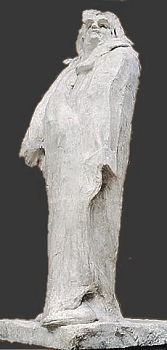 The
Société des Gens de Lettres, now presided by Henry Houssaye,
rejected Rodin´s 'Balzac' - and the payment of FF 30,000 it owed him for
his work: The
Société des Gens de Lettres, now presided by Henry Houssaye,
rejected Rodin´s 'Balzac' - and the payment of FF 30,000 it owed him for
his work:
 see Cléon, La Question Rodin à la Société des Gens de Lettres, in:
L'Echo de Paris, 12 May 1898, quoted by Grunfeld, p. 377
see Cléon, La Question Rodin à la Société des Gens de Lettres, in:
L'Echo de Paris, 12 May 1898, quoted by Grunfeld, p. 377
Rodin was in the awkward position that his admirers, who
tried to collect FF 30,000 to purchase his refused 'Balzac Monument'
and put it at a public space, were mainly supporters of the imprisoned
Jewish officer Dreyfus. In his open letter J´accuse, Zola had
taunted the military leaders with a conspiracy against the innocent
captain. Zola was summoned to court and condemned; the confrontation
between the left-wing intellectuals and the conservative forces split the
French nation. The association between Zola and Rodin may have been one of
the reasons the 'Balzac Monument' was meeting so much resistance. But
Rodin, unwilling to provoke the reigning powers, remained silent and
refused to put his name under Mirbeau's manifest to support Zola, so that
Jean Ajalbert scolded the stubborn sculptor for cowardice. In fact, Rodin
was politically much more conservative than he admitted in public. The
Norwegian author and painter Christain Krohg, who visited Rodin at that
time, complained: "Rodin is a glowing anti-Dreyfusard and
anti-Semite...".
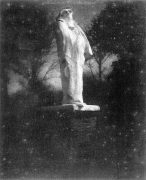 In
the end, Rodin sold his Balzac plaster neither to his friends, who were
associated with the Dreyfus camp, nor to the art collector Auguste
Pellerin,
but kept it for himself and had it place in Meudon, where it was
photographed by Edward Steichen. Apart from the necessity not to insult
his most loyal supporters by accepting the Pellerin offer, Rodin must have
felt that his work expressed something more profound and universal than
the political and social concerns of the day. His protest remained limited
to the rigid artistic regime, that had denied his entry to the Ecole
des Beaux Arts. His most urgent mission was the innovation of Art, not
of society, and in his Balzac, he saw the essence both of his subject and
of his artistic ideas condensed: "Refining the sculpture adds nothing
to the work", Rodin later explained to Maurice Mauclair. In
the end, Rodin sold his Balzac plaster neither to his friends, who were
associated with the Dreyfus camp, nor to the art collector Auguste
Pellerin,
but kept it for himself and had it place in Meudon, where it was
photographed by Edward Steichen. Apart from the necessity not to insult
his most loyal supporters by accepting the Pellerin offer, Rodin must have
felt that his work expressed something more profound and universal than
the political and social concerns of the day. His protest remained limited
to the rigid artistic regime, that had denied his entry to the Ecole
des Beaux Arts. His most urgent mission was the innovation of Art, not
of society, and in his Balzac, he saw the essence both of his subject and
of his artistic ideas condensed: "Refining the sculpture adds nothing
to the work", Rodin later explained to Maurice Mauclair.
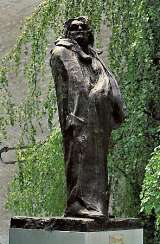 The
revolutionary character of the 'Monument to Balzac' was indeed recognized
by influential authors and artists, like Anatole France, Léon Daudet,
Antonin Proust, Paul Signac, André Fontainas, Claude Bienne and the
Belgian poet Georges Rodenbach: The
revolutionary character of the 'Monument to Balzac' was indeed recognized
by influential authors and artists, like Anatole France, Léon Daudet,
Antonin Proust, Paul Signac, André Fontainas, Claude Bienne and the
Belgian poet Georges Rodenbach:
 Georges Rodenbach, L'Élite, Paris 1899, p. 290, quoted by Grunfeld, p.
375
Georges Rodenbach, L'Élite, Paris 1899, p. 290, quoted by Grunfeld, p.
375
In his conversations with Paul Gsell, Rodin later
formulated himself:
"There was only one way to evoke my subject: I had to
show Balzac in his study, breathless, hair in disorder, eyes lost in a
dream; a genius who in his little room reconstructs a whole society piece
by piece in order to bring it to tumultuous life.. who never rests, turns
night into day, drives himself vainly to fill the holes left by his
debts..."
 Paul
Gsell, quoted by Grunfeld, p. 372 Paul
Gsell, quoted by Grunfeld, p. 372
Elsen already pointed out that Rodin must have
identified with his Balzac character, defining himself as a visionary
artist with a higher mission.
The rejection by the Societé des Gens de Lettres must have come as
am artistic and personal defeat, confirming the anticipated roles of both
Balzac and Rodin himself as misunderstood geniuses. In a letter, dated 14
November 1898, to his friend William Ernest Henley Rodin complained:
"Our lives are, in truth, somewhat similar; and I have
had, too, terrible sufferings in affection.* Profound pleasureless
melancholy has come upon me. The struggle I must carry on still wears me
out. ... What a sorry time we live in! Some believe in progress because
there are telephones, steamships, etc.; but all that is only an
improvement of the arm, the leg, the eye, the ear. Who shall improve the
soul, which will soon disappear?"
 see Wiliamson, Kennedy, W.E. Henley, London 1930, p. 251f., quoted by
Grunfeld, p. 386
see Wiliamson, Kennedy, W.E. Henley, London 1930, p. 251f., quoted by
Grunfeld, p. 386
Being frustrated and realising how much time he needed
to develop single works to complete maturity, Rodin did not complete his
other commissions for public monuments after 1898, except for the
'Monument to President Sarmiento'.
'The Monument to Whistler', for example, was left unfinished. In 1910,
Rodin told a journalist of The Morning Post:
"I am unfortunately a slow worker, being one of
those artist in whose minds the conception of work slowly take shape and
slowly comes to maturity. I lay my work aside while it is yet unfinished,
and for months I may appear to abandon it. Every now and then, however, I
return to it and correct or add a detail here and there. I have not really
abandoned it, you see, only I am hard to satisfy."
 see J. Newton and M. MacDonald, Rodin. The Whistler monument, Gazette des
Beaux-Arts 92, 1978, p.226, quoted by Catherine Lampert, Rodin - Sculpture
and Drawings, p. 135
see J. Newton and M. MacDonald, Rodin. The Whistler monument, Gazette des
Beaux-Arts 92, 1978, p.226, quoted by Catherine Lampert, Rodin - Sculpture
and Drawings, p. 135
Only 22 years after Rodin's death, on 2 July 1939, his
'Balzac' was cast in bronze and placed at the crossing of the boulevards
Montparnasse and Raspail.
* As a boy, Henley had suffered from a tubercolosis of the
bone, and a part of his leg had been amputated (see Grunfeld, p. 1389).
|